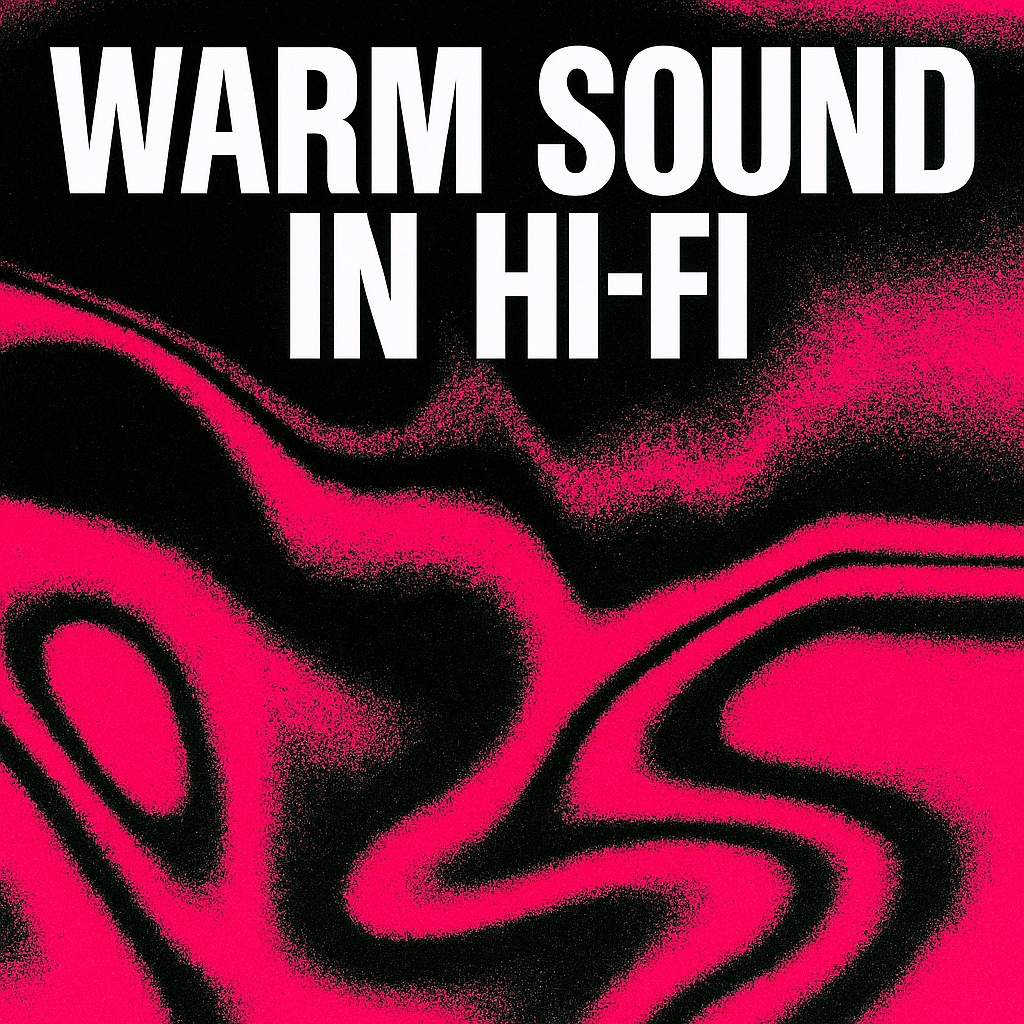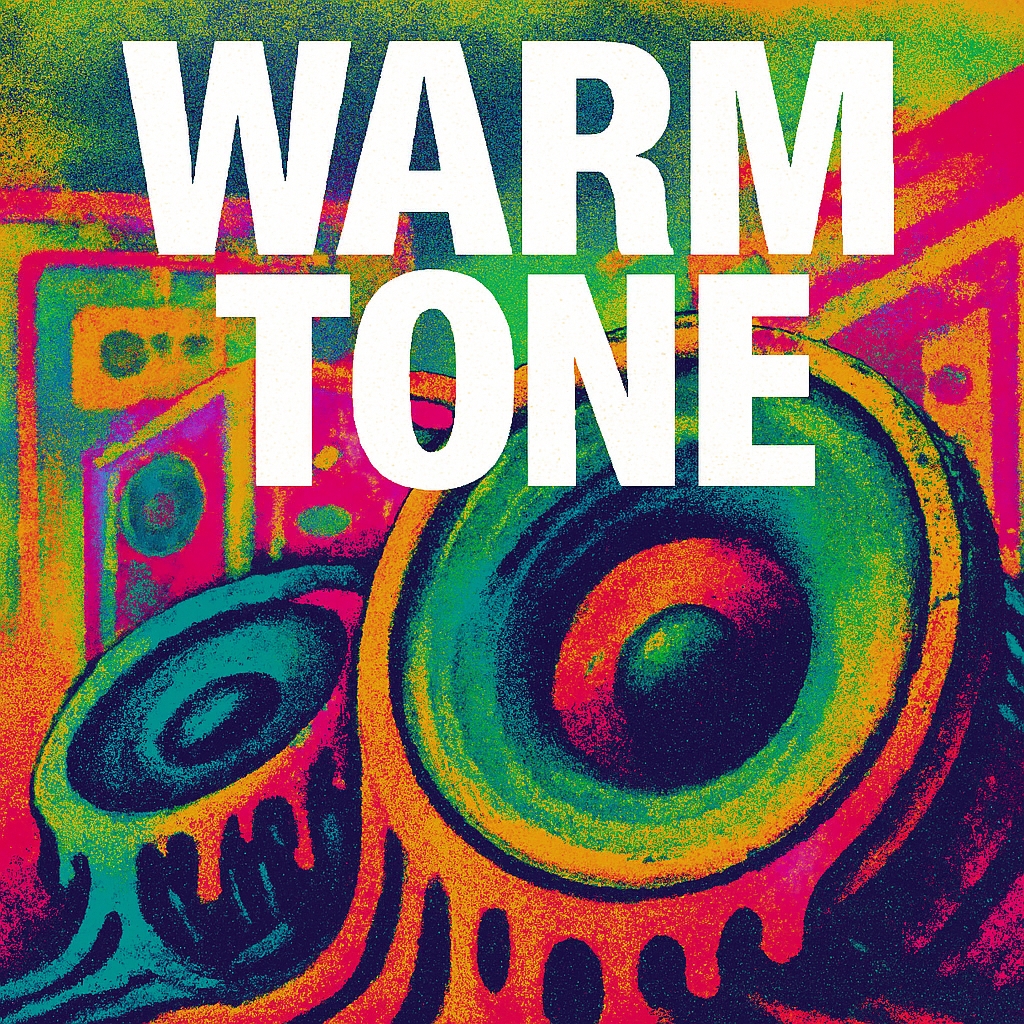WHAT WARM SOUND REALLY MEANS
Warm sound in hi-fi refers to a sonic character that feels rich, smooth, and emotionally engaging. It is not a vague preference but a result of specific acoustic traits. Warmth is shaped by a gentle emphasis in the lower midrange frequencies, typically between 200 Hz and 500 Hz. This range carries the body of vocals, the resonance of acoustic instruments, and the fullness of ambient textures.
A warm sound signature avoids harsh treble peaks and instead rolls off the upper frequencies to reduce glare. It is often associated with analog playback systems, soft-dome tweeters, and tube amplification. Warm sound is not about coloration or distortion but about enhancing musical intimacy. It invites long listening sessions by reducing fatigue and emphasizing tonal richness. The perception of warmth is influenced by gear design, room acoustics, and mastering choices. It is a deliberate tuning that prioritizes emotional resonance over analytical precision. Warm sound is not less accurate—it is differently accurate, favoring depth over detail.

WARM SOUND IN HI-FI
FREQUENCY RESPONSE AND THE FOUNDATION OF WARMTH
The frequency response of a hi-fi system plays a central role in shaping warmth. A warm signature typically features a subtle boost in the lower mids and a gentle roll-off in the upper treble. This tuning enhances the body of instruments and vocals while avoiding excessive brightness. The warmth is not created by boosting bass but by reinforcing the tonal center of the music. Speakers and headphones designed for warmth often use materials that absorb energy and reduce harsh reflections.
The result is a sound that feels grounded and full without being muddy. Warmth in frequency response is about balance, not exaggeration. It allows the listener to feel the music rather than dissect it. The smoothness of the response curve contributes to the perception of warmth. This tuning is especially effective for genres that rely on emotional depth, such as jazz, classical, and acoustic folk. Warm sound signatures are often preferred in intimate listening environments. The frequency response curve becomes a map of emotional contour.
HARMONIC DISTORTION AND SONIC TEXTURE
Warm sound is often shaped by the presence of even-order harmonic distortion, particularly second-order harmonics. These harmonics reinforce the fundamental tone and add a sense of richness and body. Tube amplifiers are known for producing this type of distortion due to their nonlinear behavior. Unlike odd-order harmonics, which can sound harsh or metallic, even-order harmonics are musically consonant and pleasing. The warmth created by harmonic distortion is not a flaw—it is a design choice that enhances musicality.
Vinyl playback systems also introduce harmonic artifacts that contribute to warmth, especially in midrange-heavy recordings. Digital systems can emulate this warmth through saturation algorithms and analog modeling. The key is subtlety—too much distortion becomes coloration, while the right amount adds depth. Harmonic distortion interacts with timbre and transient response to shape the overall sonic texture. Warmth is not about masking detail but about enriching it. The harmonic profile of a system becomes part of its emotional fingerprint.

Sonic Character Texture And Intimacy
TRANSIENT RESPONSE AND SMOOTHNESS
Warm sound often features a softened transient response, which reduces the sharpness of attacks and enhances flow. Transients are the initial bursts of energy in sounds, such as drum hits or plucked strings. Fast transients create a sense of immediacy and precision, but can also sound aggressive or fatiguing. Warm systems may round off transients through damping or slower rise times, creating a smoother presentation. This does not blur the sound—it shapes it with gentler contours.
Speakers with warm signatures often use materials like paper cones or textile surrounds that absorb energy and reduce harshness. Amplifiers with slower slew rates can also contribute to this effect. The result is a sound that feels organic and relaxed, ideal for extended listening. Smooth transients enhance the perception of warmth by reducing edge and glare. This characteristic is especially noticeable in vocals and acoustic instruments. Warmth in transient response is about musical flow, not technical compromise. It supports emotional engagement without sacrificing rhythm.
TIMBRE AND INSTRUMENTAL COLOR
Timbre refers to the tonal character of a sound, and warm systems tend to emphasize natural, rounded timbres. This means instruments sound more like themselves—woodwinds have breath, strings have body, and vocals have chest resonance. Warmth in timbre is achieved through careful tuning of frequency response and harmonic behavior.
Materials used in speaker construction, such as silk tweeters and natural fiber cones, contribute to this effect. Amplifiers that preserve harmonic integrity also enhance timbral warmth. The goal is not to color the sound but to reveal its organic texture. Warm timbre supports emotional realism, making recordings feel more lifelike. This is especially important in acoustic and vocal-heavy genres. The perception of timbre is also influenced by room acoustics and speaker placement. A warm system will present instruments with depth and nuance, avoiding the sterility of overly analytical setups. Timbre becomes a canvas for emotional storytelling. Warmth in timbre is not a trick—it is a truth revealed through design.
DYNAMIC RANGE AND EMOTIONAL DEPTH
Warm sound often benefits from a wide but gently contoured dynamic range. This means the system can reproduce both quiet and loud passages with nuance, without sounding abrupt or compressed. A warm system doesn’t flatten dynamics—it shapes them with grace. The transitions between soft and loud are smooth, allowing emotional crescendos to unfold naturally. Dynamic range interacts with warmth by preserving musical tension without harshness.
Tube amplifiers and analog sources often handle dynamics with a rounded envelope, contributing to warmth. Compression in mastering can reduce perceived warmth by limiting expressive contrast. A warm dynamic profile supports genres that rely on subtle shifts, such as chamber music or vocal jazz. It also enhances cinematic soundtracks, where emotional pacing is key. The perception of warmth increases when dynamics are fluid and unforced. Warmth is not about loudness—it’s about how loudness breathes. Dynamic range becomes a vessel for emotional storytelling.
SPEAKER DESIGN AND MATERIAL CHOICE
The materials and architecture of a speaker directly influence its warmth. Soft-dome tweeters, paper cones, and textile surrounds are known for producing smoother, warmer sound signatures. These components absorb and diffuse energy rather than reflecting it harshly. Cabinet design also matters—wooden enclosures tend to resonate in ways that enhance warmth, while metal cabinets may sound more clinical. Crossover tuning plays a role in how frequencies blend, affecting warmth in the midrange. Warm speakers often prioritize coherence over precision, allowing instruments to blend naturally.
Ported designs can add warmth through enhanced low-frequency extension, though they must be carefully tuned to avoid boominess. The internal damping materials reduce unwanted resonances, supporting a warm tonal balance. Speaker placement and toe-in angle also affect warmth by shaping how sound interacts with the room. Warmth is not just built—it’s curated through every design decision. The speaker becomes a sculptor of sonic intimacy.

AMPLIFIER CHARACTERISTICS AND SIGNAL FLOW
Amplifiers contribute to warmth through their topology, biasing, and output stage behavior. Class A amplifiers are often praised for their warm sound due to continuous current flow and minimal crossover distortion. Tube amplifiers, especially single-ended triodes, produce harmonic profiles that reinforce warmth. Solid-state designs can also be warm if tuned with slower slew rates and gentle feedback loops. The choice of capacitors, transformers, and circuit layout influences how the amplifier handles transients and harmonics. Warm amplifiers prioritize musicality over measurement perfection.
Signal path simplicity often correlates with warmth—fewer stages mean less phase shift and more tonal integrity. Balanced inputs and outputs can reduce noise, preserving warmth in complex setups. The interaction between amplifier and speaker impedance also affects warmth, especially in tube systems. Warmth in amplification is not accidental—it’s engineered through deliberate choices. The amplifier becomes a translator of emotional nuance.
DIGITAL CONVERSION AND FILTERING
Digital-to-analog converters (DACs) shape warmth through their filtering algorithms and output stages. Oversampling filters with slow roll-off preserve phase coherence and reduce pre-ringing, contributing to a smoother sound. Some DACs offer selectable filters, allowing users to choose warmer or more analytical profiles. The analog output stage of a DAC—especially if it uses discrete components or tubes—can add warmth through harmonic shaping. Bit depth and sample rate affect resolution, but warmth is more about how the signal is reconstructed. Delta-sigma designs tend to sound cleaner, while R-2R ladder DACs are often described as warmer due to their natural decay characteristics.
Warmth in digital playback is not about coloration—it’s about preserving musical flow. USB and optical inputs may sound different depending on jitter handling, which can subtly affect warmth. The DAC becomes a bridge between digital precision and analog emotion. Warmth is coded into how bits become breath.
VINYL PLAYBACK AND ANALOG CHARACTER
Vinyl playback is often associated with warmth due to its mechanical and electrical characteristics. The stylus-cartridge interaction introduces harmonic artifacts that enhance midrange richness. Phono preamps with gentle equalization curves preserve warmth by avoiding treble glare. The analog nature of vinyl means there’s no digital quantization—sound flows continuously, supporting warmth. Surface noise and groove wear can add texture, though excessive distortion reduces fidelity.
Warmth in vinyl is shaped by tracking force, stylus shape, and tonearm geometry. Belt-drive turntables tend to sound warmer than direct-drive models due to reduced motor vibration. The resonance of the platter and plinth also affects tonal balance. Vinyl mastering often emphasizes warmth to compensate for format limitations. Warmth in vinyl is not nostalgia—it’s physics and design. The turntable becomes a ritual instrument of sonic warmth.
ROOM ACOUSTICS AND LISTENING ENVIRONMENT
The acoustic properties of the listening room play a major role in perceived warmth. Hard surfaces reflect high frequencies, increasing brightness and reducing warmth. Soft furnishings, carpets, and curtains absorb treble energy, enhancing smoothness. Bass traps and diffusers help control low-frequency buildup, preventing muddiness while preserving warmth. Speaker placement relative to walls affects boundary reinforcement—closer placement can increase warmth but risks boominess.
Listening distance shapes how direct and reflected sound blend, influencing tonal perception. Warmth increases when reflections are controlled and the soundstage feels cohesive. Room dimensions and ceiling height also affect modal behavior, which can enhance or suppress warmth. Acoustic panels tuned for midrange absorption can refine warmth without deadening the room. The room becomes an extension of the system’s voice. Warmth is not just in the gear—it’s in the space it sings.
CABLES AND INTERCONNECTS
While controversial, cables and interconnects can subtly influence warmth through capacitance, shielding, and conductor material. Copper is often associated with warmer sound due to its smooth conductivity, while silver may sound brighter. Shielding reduces electromagnetic interference, preserving tonal integrity. High-capacitance cables can roll off treble slightly, enhancing warmth. Balanced cables reduce noise and maintain signal purity, supporting warmth in complex setups. Connector quality affects contact resistance, which can influence transient behavior. Warmth in cabling is not dramatic—it’s cumulative across the signal chain. The goal is not to color the sound but to preserve its emotional texture. Cables become the arteries of sonic warmth. Their influence is subtle but real in finely tuned systems.
HEADPHONE TUNING AND PERSONAL LISTENING
Headphones tuned for warmth emphasize mid-bass and lower mids while avoiding treble peaks. Closed-back designs often sound warmer due to reduced air movement and enhanced resonance. Earpad material affects absorption and reflection—velour tends to sound warmer than leather. Driver type also matters—dynamic drivers often produce warmer sound than planar magnetic or electrostatic designs. Warm headphones are ideal for vocal-heavy genres and long listening sessions. The tuning curve resembles a gentle slope, prioritizing comfort over precision. Warmth in headphones is shaped by isolation, seal quality, and amplifier pairing. Portable DAC-amps with analog output stages can enhance warmth. The headphone becomes a personal chamber of sonic intimacy. Warmth is not just heard—it’s felt in proximity.

GENRE INTERACTION AND MUSICAL FIT
Certain genres benefit more from warm sound signatures due to their tonal and emotional demands. Jazz, classical, folk, and soul often rely on midrange richness and harmonic depth. Warm systems reveal the breath in vocals, the wood in strings, and the air in recordings. Electronic music may sound less precise but more immersive on warm setups. Rock and blues gain body and grit, enhancing emotional impact. Warmth supports storytelling in music, allowing the listener to connect with the performance. Genre interaction is not about preference—it’s about synergy. Warmth becomes a lens through which music reveals its soul. The system becomes a partner in musical interpretation.
EMOTIONAL RESONANCE AND LISTENER EXPERIENCE
Warm sound enhances emotional resonance by reducing fatigue and emphasizing musical flow. It invites the listener into the recording rather than keeping them at a distance. The experience becomes immersive, not analytical. Warmth supports long listening sessions, making music feel like a companion rather than a spectacle. It enhances mood, memory, and presence. The listener feels the music in their body, not just their ears. Emotional resonance is shaped by every element in the signal chain. Warmth is not a trick—it’s a truth that emerges when design meets empathy. The system becomes a mirror of emotional depth. Warm sound is not just technical—it’s human.
Conclusion
Warm sound in hi-fi is a multidimensional phenomenon rooted in acoustic design, harmonic behavior, and emotional sensitivity. It is not a coloration or compromise—it is a deliberate tuning that prioritizes musical intimacy. From frequency response to room acoustics, every element contributes to warmth. The result is a listening experience that feels rich, smooth, and emotionally engaging. Warmth is not less accurate—it is differently accurate, favoring depth over detail. It supports storytelling, enhances mood, and invites connection. In a world of sterile precision, warm sound remains a sanctuary of sonic humanity.
Join the Discussion
How do you define warmth in your own listening setup? Which gear or recordings bring out the richest emotional textures for you?
#WarmSound #HiFiTexture #SonicEmotion #AnalogWarmth #TubeTone #SpeakerDesign #VinylVibes #AudioCraft #ListeningRoom #EmotionalResonance











Leave a Reply